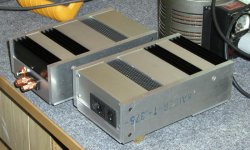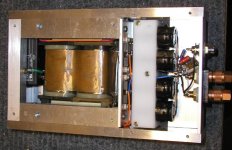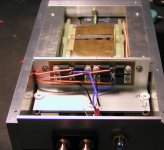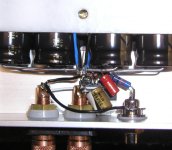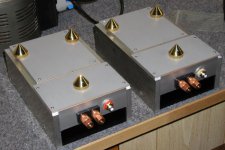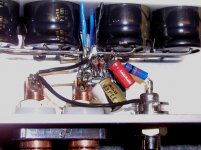Here's the pic of p2p wiring. It is as short as it gets and I used 4 x 1000/50 BG per channel. The front end PS pins are bypassed with 4.7 N BG. I used 33u for bootstrap cap (Nichicon Gold) and Riken 10K and 220K resistors. Mute and standby pins are connected with 22k and 10K resistors to pos rail. No blocking cap and no pots. I believe the signal path is less than 30mm indeed.😉 It's the length of input resistor, the chip itself and the output pin is soldered directly to the output post.
Attachments
Here's the amps in action. My comments? It seems like the amp is very stable (no oscillations and hum whatsoever). After initial hooking up, I thought that they sound very good, but after listening some more to different material, I think they sound weired. I suspect that it may be caused by that orange wiring or maybe MSR diodes, but something isn't completely right. They are very detailed and bass is great, but midrange isn't satisfactory yet. I will let them warm up and play some more. I'm not using any pot and the amps are connected directly to the DAC's output. I also used 2 BG caps in parallel per rail, maybe it's too much capacitance?😉
Attachments
Nice work! (as usual)
Those extrusions look just like the ones I'm currently using. Are they the same size as this extrusion:
<center>
<img src="http://www.accelindustrial.com/model79.gif">
</center>
se
Those extrusions look just like the ones I'm currently using. Are they the same size as this extrusion:
<center>
<img src="http://www.accelindustrial.com/model79.gif">
</center>
se
Not just another nice construction!
More pictures for my inspiring amp-pictures-folder.
I have to admit I never liked to work with metal but these little amps make me rethink and probably get into it.
Thanks again for more inspirations!
BTW: You obviously meant the TDA7294!?
I think the TDA7394 was a stereo chip.
Jens - is gonna hunt for some thick alumium bars soon

More pictures for my inspiring amp-pictures-folder.
I have to admit I never liked to work with metal but these little amps make me rethink and probably get into it.
Thanks again for more inspirations!
BTW: You obviously meant the TDA7294!?
I think the TDA7394 was a stereo chip.
Jens - is gonna hunt for some thick alumium bars soon
Yes, I meant 7294 and I already fixed my mistake.
Those are the same extrusions and I'm using 4.5" lengths. I put a 1" square bar between the fins. It improves the looks as well as acts as connecting element between 3/8" side panels and the heatsink. The angles are 1 1/2 extrusions from Home Depot. I only have to anodize the side panels, and I'll do it whenever opportunity arises. The other black thing on top is a plastic mesh I attached with double sided tape, couldn't be easier.
I also have to admit that I really like to work on those small amps. It's much easier than building big aluminum enclosures, with enough detail, it doesn't have to look plain (that was my intention this time) and the results are comparable. It's almost like working on a Swiss watch😉
Those are the same extrusions and I'm using 4.5" lengths. I put a 1" square bar between the fins. It improves the looks as well as acts as connecting element between 3/8" side panels and the heatsink. The angles are 1 1/2 extrusions from Home Depot. I only have to anodize the side panels, and I'll do it whenever opportunity arises. The other black thing on top is a plastic mesh I attached with double sided tape, couldn't be easier.
I also have to admit that I really like to work on those small amps. It's much easier than building big aluminum enclosures, with enough detail, it doesn't have to look plain (that was my intention this time) and the results are comparable. It's almost like working on a Swiss watch😉
Peter,
what are you doing with filter at AC input?😕 and
what about your cheapo AC cord and worst both not the same.
Hope they are not brand new!
what are you doing with filter at AC input?😕 and
what about your cheapo AC cord and worst both not the same.
Hope they are not brand new!

This is not a filter, it's a module containing socket, fuse and switch, very convenient.😉 I tried filter before and I didn't like it.
Regarding the cables, this is what happens when someone's in rush to listen to the new creation😉
Regarding the cables, this is what happens when someone's in rush to listen to the new creation😉
Peter Daniel said:This is not a filter, it's a module containing socket, fuse and switch, very convenient.😉 I tried filter before and I didn't like it.
Regarding the cables, this is what happens when someone's in rush to listen to the new creation😉
Speaking of that... any idea where one could get a module like that online and how much it would cost? I really like the look of it.
Anyway, even your slapped together amps are far superior in quality than mine will ever be.
 Also, that p2p wiring is truly inspirational.
Also, that p2p wiring is truly inspirational.I'm buying my AC modules locally from this surplus outlet: http://www.sayal.com/. But I don't know the part #. I think it's less than $10.
Hee's more p2p inspiration.
Hee's more p2p inspiration.
Attachments
When ground is not ground....
I'm not surprised...you have connected the input ground to the negatif speaker terminal...where the loudspeaker retourning currents, retourn to the filter capacitors...and that current produces spurious voltages at that point...
The input ground must be conected to the ground terminal of the IC(in this case the noninverting input) ...that is also conected to the comum ground point(in a inverting amp)...!!
Here's the amps in action. My comments? It seems like the amp is very stable (no oscillations and hum whatsoever). After initial hooking up, I thought that they sound very good, but after listening some more to different material, I think they sound weired.
I'm not surprised...you have connected the input ground to the negatif speaker terminal...where the loudspeaker retourning currents, retourn to the filter capacitors...and that current produces spurious voltages at that point...
The input ground must be conected to the ground terminal of the IC(in this case the noninverting input) ...that is also conected to the comum ground point(in a inverting amp)...!!
In all my other amps the common ground point was always at the speaker's terminal and they sounded fine (not weired). With a distance of no more than 20mm, I don't think it makes much difference where the grounds are connected, it's just that the speaker terminal is convenient point for star ground. My other option was common point at the filter caps, but here I thought the currents might be more disturbing.
BTW, I tried connecting input ground as you propose in the other gainclone and it didn't make any audible difference. Probably because it measured the same.😉
BTW, I tried connecting input ground as you propose in the other gainclone and it didn't make any audible difference. Probably because it measured the same.😉
Peter Daniel said:Those are the same extrusions and I'm using 4.5" lengths.
Ah. Did you find those somewhere already cut and anodized?
I put a 1" square bar between the fins. It improves the looks as well as acts as connecting element between 3/8" side panels and the heatsink.
Yeah, I used a trim strip on mine as well. But in my case, the PA-02 (which is in a TO-3 case) is mounted from the channel side and the input transformer protudes into the channel from the bottom of the sink so that stuff needed to be covered up.
I also have to admit that I really like to work on those small amps. It's much easier than building big aluminum enclosures, with enough detail, it doesn't have to look plain (that was my intention this time) and the results are comparable. It's almost like working on a Swiss watch😉
Yup. I know exactly what you mean.
se
The danger of posting pics
I clearly see a ground error on your ground arrangement but if you can’t see it/hear it, it’s no mistake at all 😀😀😀
Regards
I clearly see a ground error on your ground arrangement but if you can’t see it/hear it, it’s no mistake at all 😀😀😀
Regards
- Status
- Not open for further replies.
- Home
- Amplifiers
- Chip Amps
- Gainclone monoblocks
